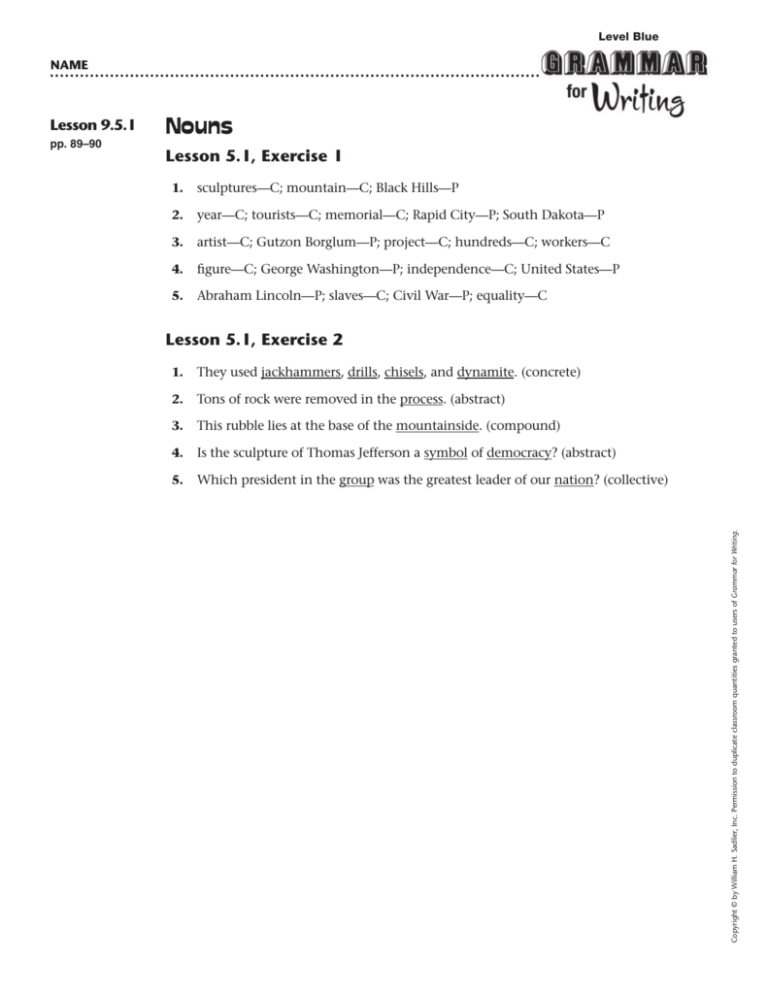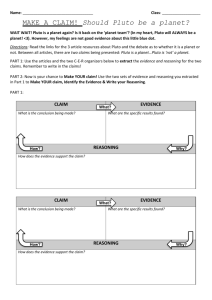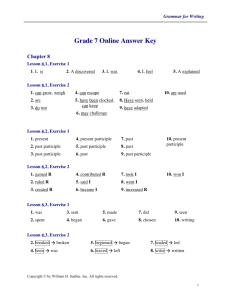Answer key - Northern Highlands Regional HS
advertisement

Level Blue NAME pp. 89–90 Nouns Lesson 5.1, Exercise 1 1. sculptures—C; mountain—C; Black Hills—P 2. year—C; tourists—C; memorial—C; Rapid City—P; South Dakota—P 3. artist—C; Gutzon Borglum—P; project—C; hundreds—C; workers—C 4. figure—C; George Washington—P; independence—C; United States—P 5. Abraham Lincoln—P; slaves—C; Civil War—P; equality—C Lesson 5.1, Exercise 2 1. They used jackhammers, drills, chisels, and dynamite. (concrete) 2. Tons of rock were removed in the process. (abstract) 3. This rubble lies at the base of the mountainside. (compound) 4. Is the sculpture of Thomas Jefferson a symbol of democracy? (abstract) 5. Which president in the group was the greatest leader of our nation? (collective) Copyright © by William H. Sadlier, Inc. Permission to duplicate classroom quantities granted to users of Grammar for Writing. Lesson 9.5.1 Level Blue NAME pp. 91–92 Pronouns Lesson 5.2, Exercise 1 1. PER; POS 2. IND; D 3. INT; POS 4. IND; PER 5. I; REF 6. POS; PER 7. IND; POS 8. IND; IND; INT 9. PER; POS 10. D; IND Lesson 5.2, Exercise 2 Answers will vary. Sample answers are shown. 1. I; himself 2. anybody; his 3. some; their 4. Our; those 5. we; all Copyright © by William H. Sadlier, Inc. Permission to duplicate classroom quantities granted to users of Grammar for Writing. Lesson 9.5.2 Level Blue NAME pp. 93–94 Verbs Lesson 5.3, Exercise 1 1. Scientists spent years in debate before they agreed on what makes a planet a planet. 2. I was surprised when I learned that this term had not been given an official definition before. 3. What characteristics do you think a planet must have? 4. A planet is an object that orbits the sun and is large enough so that the force of its own gravity gives it a round shape. 5. The new definition also says that a planet must “dominate” the area through which it moves as it orbits the sun. Lesson 5.3, Exercise 2 1 When scientists say that a planet “dominates” the area through which it orbits, they mean that the planet is the largest object in the neighborhood. 2 Pluto has the moon Charon. 3 (Pluto appears as the ruler of the Underworld in Roman mythology, and Charon is the name of the ferryman who takes the souls of the dead across the River Styx.) 4 Pluto’s moon Charon is more than half the size of the object it orbits. 5 All true planets, like our own Earth, are far larger than their moons. 6 Scientists examine another feature of an object in space when they decide if it “dominates” its area. 7 Does the object’s gravity exercise enough attraction so that the orbiting body “sweeps” away small objects such as asteroids as it moves around the sun? 8 In other words, is its orbit “tidy” enough to say that Pluto is a planet? 9 Because its orbit seems messy, scientists have classified Pluto as only a “dwarf planet.” 10 Pluto, however, is not alone; scientists already have already discovered forty-four other “dwarf planets.” Copyright © by William H. Sadlier, Inc. Permission to duplicate classroom quantities granted to users of Grammar for Writing. Lesson 9.5.3 Level Blue NAME pp. 95–96 Identifying Adjectives Lesson 5.4, Exercise 1 1. PRED Persian territory was vast. 2. _____ For effective communication, the rulers of Persia needed a road for royal couriers. 3. _____ The eastern end of the road was the imperial capital of Susa. 4. _____ The western ends were the Mediterranean ports of Ephesus and Smyrna. 5. _____ The early road stretched more than 1,500 miles from end to end. 6. PRED By ancient standards, the royal couriers who traveled the highway were swift. 7. _____ The Greek historian Herodotus wrote about the couriers. 8. _____ He estimated that they covered the entire route in twenty days. 9. _____ According to Herodotus, there were excellent stops along the long road. 10. PRED The region the road ran through was inhabited and safe. Lesson 5.4, Exercise 2 Answers will vary. Sample answers are shown. 1. This beautiful, well-researched book is about the Persian Empire. 2. The historical description of the royal road is accurate and interesting. 3. I thought about the tiring journeys the brave couriers took. 4. The faithful, courageous couriers did a very good job when carrying out their vital missions. 5. Have you ever had to take a long and demanding journey? Copyright © by William H. Sadlier, Inc. Permission to duplicate classroom quantities granted to users of Grammar for Writing. Lesson 9.5.4 Level Blue NAME pp. 97–98 Adverbs Lesson 5.5, Exercise 1 1 It is so surprising to me that the English scientist James Smithson left this gift to the United States, a country he never saw. 2 More amazing is that Americans nearly lost Smithson’s gift because some members of Congress stubbornly refused to let the federal government accept it. 3 That surely would have been a very great loss to learning in the United States! 4 I learned that it was largely through the efforts of former president John Quincy Adams, who served in Congress after leaving the White House, that Americans finally gained this extraordinary legacy in 1846. 5 The Smithsonian’s first home, the building known today as the Castle, was completed in 1855. 6 Almost certainly, my favorite place is the huge National Air and Space Museum. Lesson 5.5, Exercise 2 Sentences will vary. Sample answers are shown. 1. What does she particularly like about the museum now? 2. I am always moved deeply by exhibits like the Spirit of St. Louis. 3. A crowd never waited so excitedly to see a new exhibit. 4. My friend waved to me even more impatiently from the museum steps. 5. Today, I almost ran into the museum guard. Copyright © by William H. Sadlier, Inc. Permission to duplicate classroom quantities granted to users of Grammar for Writing. Lesson 9.5.5 Level Blue NAME pp. 99–100 Prepositions Lesson 5.6, Exercise 1 1. This bridge spans the East River in New York City, linking Manhattan to Brooklyn. 2. Brooklyn Bridge was the greatest achievement of American civil engineer John Roebling. 3. Roebling was born in 1806 in what is now Germany. 4. Emigrating to the United States at the age of 25, he eventually built a successful factory that produced wire cable. 5. The state of New York offered Roebling the huge challenge of building a bridge across the East River because of his success with long-span suspension bridges. 6. Sadly, he died at the outset of construction in 1869. 7. His death resulted from a fatal illness that was caused by an accident at the building site. 8. Roebling’s son Washington brought the construction of the bridge to completion. 9. The bridge was completed in 1883 after 14 years of work. 10. Washington Roebling finished the project in spite of a crippling illness. Lesson 5.6, Exercise 2 1. A Confined inside, Roebling observed the construction through field glasses. 2. P Since Roebling could not go out of his apartment, his wife Emily carried messages to the building site. 3. A When work on the bridge was through, New York City marked its completion with a big celebration. 4. P For Americans of this time, the Brooklyn Bridge became a symbol of U.S. achievement. 5. A Due to the bridge’s power and beauty, the hearts of many Americans were lifted up. Copyright © by William H. Sadlier, Inc. Permission to duplicate classroom quantities granted to users of Grammar for Writing. Lesson 9.5.6 Level Blue NAME pp. 101–102 Conjunctions and Interjections Lesson 5.7, Exercise 1 1 A series of four shocks took place there in December 1811 and January 1812, and they are called the New Madrid earthquakes. 2 Because of the widespread damage and changes to the landscape they caused, the New Madrid quakes rank among the most severe in North American history. 3 Neither the earthquake in Alaska in 1964 nor the one in San Francisco in 1906 produced such large areas of strong shaking. 4 The quakes are named for New Madrid, Missouri, but the first two struck northeast Arkansas. 5 Ground either rose up or sank beneath water that came through cracks in the earth. 6 There were huge waves on the Mississippi River, so boats were washed high up on shore. 7 Riverbanks caved in, and whole islands disappeared. 8 The third and fourth earthquakes took place a month later. 9 The final shocks destroyed the town of New Madrid, and many houses were badly damaged as far away as St. Louis. Lesson 5.7, Exercise 2 Answers will vary. Sample answers are shown. 1. Hey, did you feel that earthquake last night? 2. Wow! I slept right through it. 3. Boy, you must be a sound sleeper! 4. Well, how severe was it? 5. A cup of hot tea spilled on me. Ouch! Copyright © by William H. Sadlier, Inc. Permission to duplicate classroom quantities granted to users of Grammar for Writing. Lesson 9.5.7 Level Blue NAME p. 103 Determining a Word’s Part of Speech Lesson 5.8, Exercise 1. Sir David Brewster, the scientist who invented the first practical stereoscope, was British. (adjective) 2. The famous American writer Oliver Wendell Holmes developed a simpler type of stereoscope that was held in the viewer’s hand. (noun) 3. Because Holmes’s design could be produced inexpensively, it became very popular. (adverb) 4. I once bought an old Holmes-type stereoscope that I found when I was in an antique store. (verb) 5. What do you call the type of photographs that people used in their stereoscopes? (pronoun) 6. Oh, I remember now; they’re called “stereographs.” (interjection) 7. Both extraordinary events (such as battles) and familiar ones (such as children playing) were popular subjects. (conjunction) 8. The famous images that Mathew Brady exhibited of the battle of Antietam during the Civil War were made as stereographs. (noun) 9. In addition to serious subjects, the old stereographs also present humor—like a series of scenes showing a practical joke. (preposition) 10. I myself have not seen any of them. (pronoun) 11. World’s fairs were really popular subjects for stereographs once and were often sold as souvenirs. (adverb) 12. According to this article, you can make simple stereographs fairly easily with two disposable cameras. (preposition) 13. This technique sounds easy and fun, but I haven’t tried it. (conjunction) 14. The stereoscope may have gone out of fashion, but 3-D movies are very popular today. (verb) 15. When I look through a stereoscope, even an old-fashioned scene seems so detailed and real. (adjective) Copyright © by William H. Sadlier, Inc. Permission to duplicate classroom quantities granted to users of Grammar for Writing. Lesson 9.5.8









